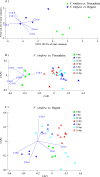The interplay between membrane lipids and phospholipase A family members in grapevine resistance against Plasmopara viticola
- PMID: 30266912
- PMCID: PMC6162203
- DOI: 10.1038/s41598-018-32559-z
The interplay between membrane lipids and phospholipase A family members in grapevine resistance against Plasmopara viticola
Erratum in
-
Author Correction: The interplay between membrane lipids and phospholipase A family members in grapevine resistance against Plasmopara viticola.Sci Rep. 2019 Apr 25;9(1):6731. doi: 10.1038/s41598-019-42135-8. Sci Rep. 2019. PMID: 31019195 Free PMC article.
Abstract
Grapevine downy mildew, caused by the biotrophic oomycete Plasmopara viticola, is one of the most important diseases in modern viticulture. The search for sustainable disease control measure is of extreme importance, thus becoming imperative to fully characterize the mechanisms leading to an incompatible interaction. We have previously shown that lipid signalling events play an important role in grapevine's response to this pathogen, namely through changes in linolenic acid content, lipid peroxidation and jasmonic acid synthesis. Here, we have characterized the modulation of lipid metabolism in leaves from two V. vinifera cultivars (resistant and susceptible to P. viticola) in the first hours after pathogen inoculation. Prior to pathogen inoculation both genotypes present an inherently different fatty acid composition that is highly modulated in the resistant genotype after pathogen challenge. Such changes involve modulation of phospholipase A activity suggesting that the source of lipids mobilized upon pathogen infection are the chloroplast membranes. This work thus provides original evidence on the involvement of lipid signalling and phospholipases in grapevine immune responses to pathogen infection. The results are discussed considering the implications on the plant's physiological status and the use of discriminating lipid/fatty acids pattern in future selection procedures of cultivars.
Conflict of interest statement
The authors declare no competing interests.
Figures








Similar articles
-
Fatty Acid Desaturases: Uncovering Their Involvement in Grapevine Defence against Downy Mildew.Int J Mol Sci. 2021 May 22;22(11):5473. doi: 10.3390/ijms22115473. Int J Mol Sci. 2021. PMID: 34067363 Free PMC article.
-
Grapevine Rpv3-, Rpv10- and Rpv12-mediated defense responses against Plasmopara viticola and the impact of their deployment on fungicide use in viticulture.BMC Plant Biol. 2021 Oct 14;21(1):470. doi: 10.1186/s12870-021-03228-7. BMC Plant Biol. 2021. PMID: 34649524 Free PMC article.
-
Specific adjustments in grapevine leaf proteome discriminating resistant and susceptible grapevine genotypes to Plasmopara viticola.J Proteomics. 2017 Jan 30;152:48-57. doi: 10.1016/j.jprot.2016.10.012. Epub 2016 Oct 27. J Proteomics. 2017. PMID: 27989945
-
The pathogenicity of Plasmopara viticola: a review of evolutionary dynamics, infection strategies and effector molecules.BMC Plant Biol. 2024 Apr 24;24(1):327. doi: 10.1186/s12870-024-05037-0. BMC Plant Biol. 2024. PMID: 38658826 Free PMC article. Review.
-
Advances in understanding grapevine downy mildew: From pathogen infection to disease management.Mol Plant Pathol. 2024 Jan;25(1):e13401. doi: 10.1111/mpp.13401. Epub 2023 Nov 22. Mol Plant Pathol. 2024. PMID: 37991155 Free PMC article. Review.
Cited by
-
A Lipidomic Analysis of Leaves of Esca-Affected Grapevine Suggests a Role for Galactolipids in the Defense Response and Appearance of Foliar Symptoms.Biology (Basel). 2020 Sep 4;9(9):268. doi: 10.3390/biology9090268. Biology (Basel). 2020. PMID: 32899845 Free PMC article.
-
Speaking the language of lipids: the cross-talk between plants and pathogens in defence and disease.Cell Mol Life Sci. 2021 May;78(9):4399-4415. doi: 10.1007/s00018-021-03791-0. Epub 2021 Feb 27. Cell Mol Life Sci. 2021. PMID: 33638652 Free PMC article. Review.
-
Semi-Targeted Profiling of the Lipidome Changes Induced by Erysiphe Necator in Disease-Resistant and Vitis vinifera L. Varieties.Int J Mol Sci. 2023 Feb 17;24(4):4072. doi: 10.3390/ijms24044072. Int J Mol Sci. 2023. PMID: 36835477 Free PMC article.
-
Grapevine-Associated Lipid Signalling Is Specifically Activated in an Rpv3 Background in Response to an Aggressive P. viticola Pathovar.Cells. 2023 Jan 21;12(3):394. doi: 10.3390/cells12030394. Cells. 2023. PMID: 36766736 Free PMC article.
-
Transcriptomic and methylation analysis of susceptible and tolerant grapevine genotypes following Plasmopara viticola infection.Physiol Plant. 2022 Sep;174(5):e13771. doi: 10.1111/ppl.13771. Physiol Plant. 2022. PMID: 36053855 Free PMC article.
References
Publication types
MeSH terms
Substances
Grants and funding
- PhD grant/Universidade de Lisboa (University of Lisbon)/International
- PD/BD/131030/2017/Ministry of Education and Science | Fundação para a Ciência e a Tecnologia (Portuguese Science and Technology Foundation)/International
- UID/MAR/04292/2013/Ministry of Education and Science | Fundação para a Ciência e a Tecnologia (Portuguese Science and Technology Foundation)/International
- SFRH/BPD/115162/2016/Ministry of Education and Science | Fundação para a Ciência e a Tecnologia (Portuguese Science and Technology Foundation)/International
- IF/00819/2015/Ministry of Education and Science | Fundação para a Ciência e a Tecnologia (Portuguese Science and Technology Foundation)/International
LinkOut - more resources
Full Text Sources
Other Literature Sources

